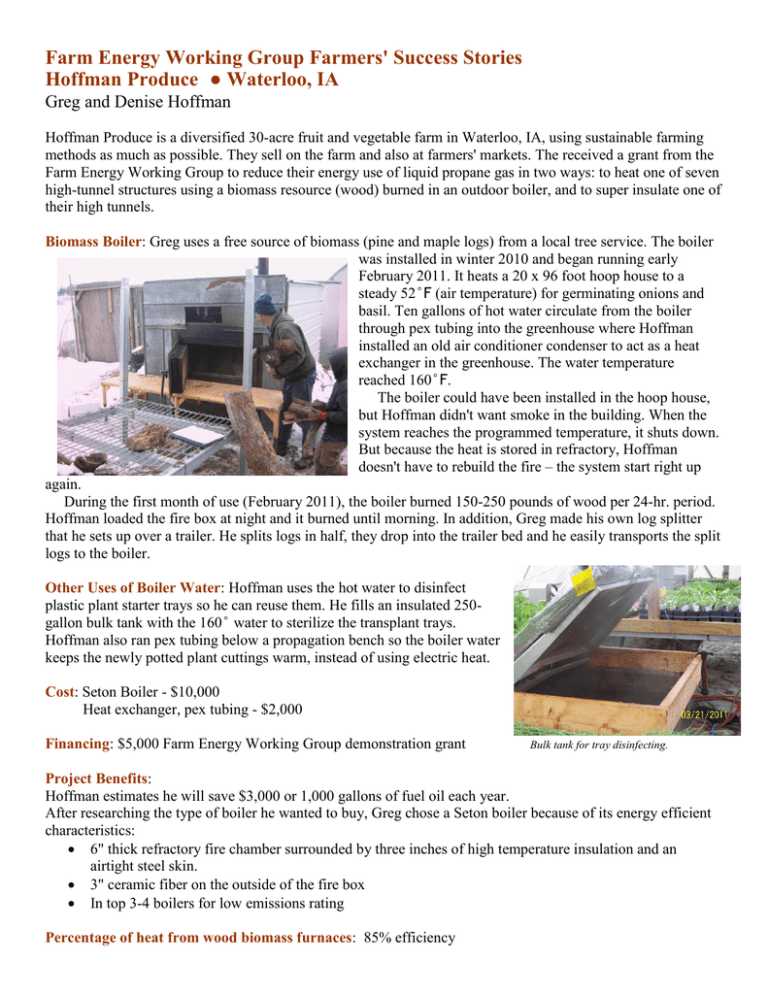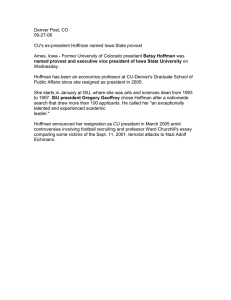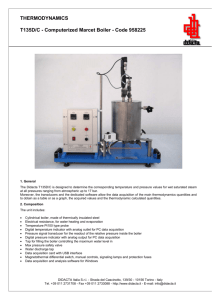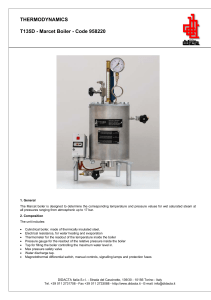Farm Energy Working Group Farmers' Success Stories Greg and Denise Hoffman
advertisement

Farm Energy Working Group Farmers' Success Stories Hoffman Produce ● Waterloo, IA Greg and Denise Hoffman Hoffman Produce is a diversified 30-acre fruit and vegetable farm in Waterloo, IA, using sustainable farming methods as much as possible. They sell on the farm and also at farmers' markets. The received a grant from the Farm Energy Working Group to reduce their energy use of liquid propane gas in two ways: to heat one of seven high-tunnel structures using a biomass resource (wood) burned in an outdoor boiler, and to super insulate one of their high tunnels. Biomass Boiler: Greg uses a free source of biomass (pine and maple logs) from a local tree service. The boiler was installed in winter 2010 and began running early February 2011. It heats a 20 x 96 foot hoop house to a steady 52°F (air temperature) for germinating onions and basil. Ten gallons of hot water circulate from the boiler through pex tubing into the greenhouse where Hoffman installed an old air conditioner condenser to act as a heat exchanger in the greenhouse. The water temperature reached 160°F. The boiler could have been installed in the hoop house, but Hoffman didn't want smoke in the building. When the system reaches the programmed temperature, it shuts down. But because the heat is stored in refractory, Hoffman doesn't have to rebuild the fire – the system start right up again. During the first month of use (February 2011), the boiler burned 150-250 pounds of wood per 24-hr. period. Hoffman loaded the fire box at night and it burned until morning. In addition, Greg made his own log splitter that he sets up over a trailer. He splits logs in half, they drop into the trailer bed and he easily transports the split logs to the boiler. Other Uses of Boiler Water: Hoffman uses the hot water to disinfect plastic plant starter trays so he can reuse them. He fills an insulated 250gallon bulk tank with the 160° water to sterilize the transplant trays. Hoffman also ran pex tubing below a propagation bench so the boiler water keeps the newly potted plant cuttings warm, instead of using electric heat. Cost: Seton Boiler - $10,000 Heat exchanger, pex tubing - $2,000 Financing: $5,000 Farm Energy Working Group demonstration grant Bulk tank for tray disinfecting. Project Benefits: Hoffman estimates he will save $3,000 or 1,000 gallons of fuel oil each year. After researching the type of boiler he wanted to buy, Greg chose a Seton boiler because of its energy efficient characteristics: 6" thick refractory fire chamber surrounded by three inches of high temperature insulation and an airtight steel skin. 3" ceramic fiber on the outside of the fire box In top 3-4 boilers for low emissions rating Percentage of heat from wood biomass furnaces: 85% efficiency Technical Specifications: For Seton boiler, go to http://www.rohor.com/page5.html Installation Date: Winter 2010-11 Super-insulated Hoop House: Greg Hoffman upgraded the plastic on a 20 x 48' hoop house oriented east/west for a better insulated structure with a higher R value. Here's what he did: Replaced a single layer of 6 mil. poly or greenhouse poly with two layers of Tufflite 6 mil. greenhouse plastic. Inner layer is an infrared energy saving plastic. Inflated space between the layers with air from a small squirrel cage blower adjusted to maintain 0.30.5" of water column pressure. This should increase R-value from .87 to 1.7. Installed foil-faced insulating material/radiant barrier on the north wall that is 8' high x 48' wide to reflect 97% of radiant heat. Greg calls this a double bubble insulation layer. Upgraded hoop house end walls with 8 mm. Twin wall Palram polycarbonate sheets to increase R-value from 0.87 to 1.7. Should last 20 years. Cost $80-100 per sheet. South side can be rolled up for natural ventilation when it gets too hot. January temps inside the hoop house got up to 124°F. Reused black oil tank barrels with water act as heat sync inside hoop house to absorb heat and give off heat during the night. Easy to install. Cost: $2,000 Hoop House insulating materials Financing: Farm Energy Working Group demonstration grant Project Benefits: Night time February lows in upgraded hoop house were 10°higher than in a hoop house without upgrades. 30-40% reduction in LP gas use.



